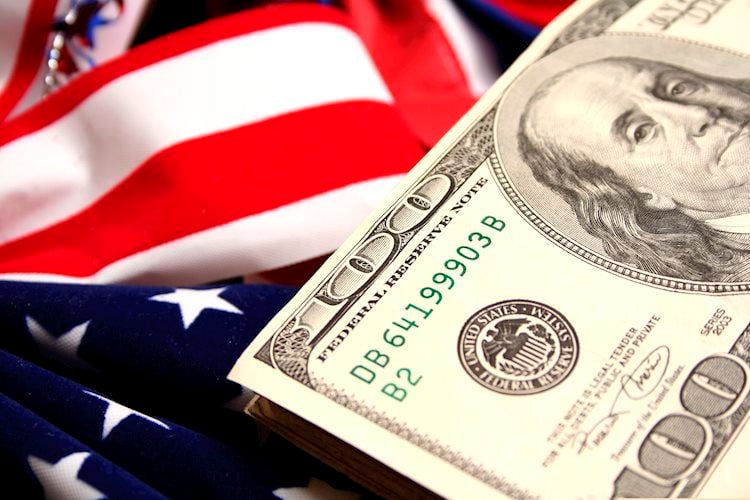
- The US Dollar roars on higher inflation numbers.
- Rate differential between US Dollar widens against most major peers and pushes US Dollar valuation higher
- The US Dollar Index heads to 105 with equities in Risk Off
The US Dollar (USD) is giving markets a kick in the nuts on all fronts. The US Consumer Price Index (CPI) numbers is coming in higher than expected on both the Core and Headline Inflation for both the Monthly and Yearly benchmarks. The upbeat surprise is a cold shower for markets which were tilted to further disinflation with only worrying about either a March or June rate cute, while under these conditions even a June rate cut is starting to look very doubtfull.
On the economic front, The National Federation of Independent Business (NFIB) saw a quicker than expected decline in its Index for January ahead of the US Consumer Price Index numbers. CPI numbers already moved the markets substantially and are pushing overall sentiment into Risk Off. Equities are plunging lower, yields are jumping higher and rate cut expectations are being pushed further down the line with hopes for quick rate cuts being shelved for now.
Daily digest market movers: That had to hurt!
- The National Federation of Independent Business (NFIB) has released its Business Optimism Index for January and saw a quick decline from 91.9 to 89.9 where 91.1 was expected.
- At 13:30 GMT, the US Consumer Price Index is due to be released:
- Monthly Headline Inflation went from 0.2% to 0.3%.
- Monthly Core Inflation went from 0.3% to 0.4%.
- Yearly Headline Inflation went from 3.4% to 3.1%, les disinflationary as expected.
- Yearly Core Inflation remained steady at 3.9%
- Rate Cut expectations are being pushed to later dates on the back of this inflation report, with higher yields giving the US Dollar an upward drive against most major peers in the currency markets.
- The US Redbook Index for February 9th is due to be released near 13:55 GMT. Previous print was at 6.1%.
- Equity markets are very much dispersed this Tuesday, with Japan seeing its two major indices closing over 2% higher. Europe is not following suit and rather sees its Euro Stoxx 50 down near 1%. US equity futures are retreating as well after the Dow Jones briefly hit new all time highs on Monday.
- The CME Group’s FedWatch Tool is now looking at the March 20th meeting. Expectations for a pause are 84.5%, while 15.5% for a rate cut.
- The benchmark 10-year US Treasury Note trades near 4.28%, over a one-month-high.
US Dollar Index Technical Analysis: Hopes for cuts dampened
The US Dollar Index (DXY) is roaring with this hot inflation report. The disinflationary path that markets had projected no longer fits the actual situation the recent CPI report has shown. Rate cuts will not happen in March and even June looks unlikely at this moment. So time for more push-and-pull readjustment in the US Dollar with this time more upside in the DXY, heading to 105.
Should the US Dollar Index move higher again, first look for a test at the peak of last week’s Monday, near 104.60. That level needs to be broken and is more important than the 100-day Simple Moving Average snap at 104.26. If price breaks above last Monday’s high (February 5), the road is open for a jump to 105.00 with 105.12 as key levels to keep an eye on.
The first ideal candidate for support is the 200-day SMA near 103.64. Should that give way, look for support from the 55-day SMA near 103.04 itself. Should those fail, look for 102.00 as a big figure to do the necessary.
Fed FAQs
Monetary policy in the US is shaped by the Federal Reserve (Fed). The Fed has two mandates: to achieve price stability and foster full employment. Its primary tool to achieve these goals is by adjusting interest rates.
When prices are rising too quickly and inflation is above the Fed’s 2% target, it raises interest rates, increasing borrowing costs throughout the economy. This results in a stronger US Dollar (USD) as it makes the US a more attractive place for international investors to park their money.
When inflation falls below 2% or the Unemployment Rate is too high, the Fed may lower interest rates to encourage borrowing, which weighs on the Greenback.
The Federal Reserve (Fed) holds eight policy meetings a year, where the Federal Open Market Committee (FOMC) assesses economic conditions and makes monetary policy decisions.
The FOMC is attended by twelve Fed officials – the seven members of the Board of Governors, the president of the Federal Reserve Bank of New York, and four of the remaining eleven regional Reserve Bank presidents, who serve one-year terms on a rotating basis.
In extreme situations, the Federal Reserve may resort to a policy named Quantitative Easing (QE). QE is the process by which the Fed substantially increases the flow of credit in a stuck financial system.
It is a non-standard policy measure used during crises or when inflation is extremely low. It was the Fed’s weapon of choice during the Great Financial Crisis in 2008. It involves the Fed printing more Dollars and using them to buy high grade bonds from financial institutions. QE usually weakens the US Dollar.
Quantitative tightening (QT) is the reverse process of QE, whereby the Federal Reserve stops buying bonds from financial institutions and does not reinvest the principal from the bonds it holds maturing, to purchase new bonds. It is usually positive for the value of the US Dollar.